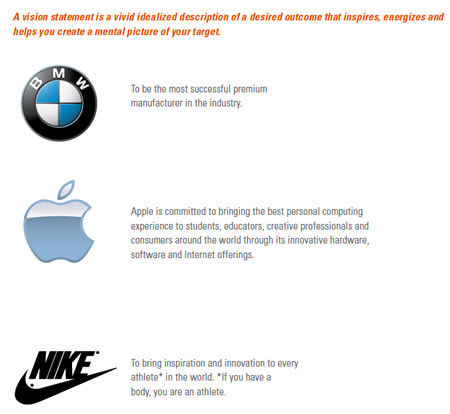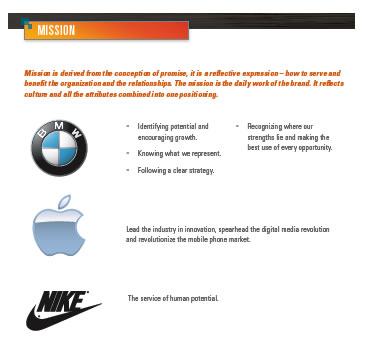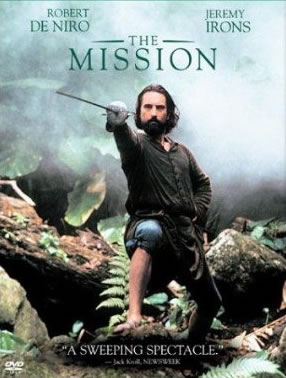
Visioning mission, promise, proposal, proposition and the inculcation of values, notations on design thinking and strategic attention.
“Vision can be written, it’s scribing a dream; it’s a designed evocation — a voicing. Mission is that act — in daily envoy — the promise progressively, that will carry that, and send that action out into the world.”
As we enter the beginning of the year, it’s a time of exploration, examination, self-scrutiny and the consideration of what messages and forms of expression “worked”, in 2009, and what didn’t. Invariably, over the course of the last number of months, people come to Girvin, thinking about the planning of marketing and communications strategies over the coming year. The smart ones are underway in the summer, a time when one might’ve expected that many would’ve been in the full breach of self examination and planning, for 2010. By the closure of the year, they’re on the way — either the strategy is defined, empowered, rolling to development or implementation.
But most weren’t. Instead, like what we experienced and along with many of our clients, relationships, and our friends, it was lean survival. Focus on the work at hand, what you’ve got, and how to survive the next grouping of impulses. Breathe. Hang on. Everywhere, that’s what we’ve heard.
Some groups that we’ve worked did begin that “discussion” — “okay, we’ve made this far, perhaps we should be looking at what we stand for, how that’s expressed, what that means for the team, and finally, for the clients — what’s the story, what it is the telling and what does it look and feel like?”
Having been through this exercise dozens of times, I’m finding myself questioning the typical structuring of mission, vision, values, creed and credence — what, really, does all that mean, and how might it be possible to rethink it? As a leader, and in engaging in dozens and dozens of explorations of the BrandQuest® for positioning strategy and visualizations, the real challenge is not necessarily the idea of doing the exercising to explore the conceptions of mission and visioning, and the fall-out of principles of application in action, it’s about the power of a fundamental story that people believe in, and they are there, working, because they believe in that story. And that they feel that there’s some stability and strength in the story of that application — and most importantly, the potential for personal growth and value addition — and that these evolutions will be meaningful in the course of their living (their lives).
Over time, I’ve come to question this sequence because I’m questioning the implementation and the valued incorporation of these messages into the layering of culture. Meaning — sure, the idea of writing a mission is cool, but what’s the point and who really cares about it? Is, for example, mission really “mission-able”? And that’s what I’m really curious about, brandcult/culture/cultivation. and the concept of how the “body” buys into the “mind and spirit” of the brand. You might know how we think about brand. And fire. Brand and fire is about passion. And we know, and you might know, as well, about passion. And it is it, passion, that the concept of these alignments, on all these hinge — of action and message.
Leadership, visioning mission and the longest shadow
The belief has to begin in the top, with not only the leader, but the team that rings that center point, the vibe of the human ignition, the echoing reflection of leadership. So how does that work, really, with a team? I was thinking about it in the context of other clients, other relationships. Speaking of relationships, I have had a couple of runs, with Chris Anderson and Wired Magazine. Wired has been — like all of us, in the communications and marketing realms — really challenged over the course of the last couple of years. My role there, design, story, interaction: what’s the crossover, between one, the other, Chris Anderson, Margaret Swart, and others? What sews it together? For the sake of such technological and marketing sophistication, what’s the story at Fast Company? So what about their mission? Their writers spent ( a lot of ) time thinking about that. Many writers trying to write a mission. What a mess. But?
The upside, getting everyone together, the downside, nine hours of having a facilitated brandstorming that’s building about a mission. What did they net?
Interestingly enough, in the overview, it wasn’t even mentioned. But I found it, and here it is.
Fast Company missionary work:
Fast Company is for people who are passionate about their work and want to do it better. Our readers are mavericks, innovators and business builders who are driven to succeed by working and leading differently. They see work as a source of personal growth and an opportunity to make a positive impact on the world around them.
Only Fast Company gives them the ideas, insights and tools they must have to do those things in an unpredictable, fast-moving, and fiercely competitive world. Our hallmark is the “thought service” story—useful and cutting-edge ideas packaged in a richly reported and compellingly written narrative. Bold design captures the energy, the drama, and the excitement of business.
Fast Company is provocative, accessible, surprising, and fun. We challenge the conventional wisdom about business and inspire readers to learn more. Reading Fast Company is like sitting down for an intimate chat with a smart and trusted friend.
I’m not sure that I get this, as a mission. This reads more like an overview of demographic response and positioning. Who works there, and why. Who reads the magazine and so — what? Assets are? They live like, and such? There’s one key action that relates to the heart of the matter, we’d suggest that actually, this is the mission: a source of personal growth and an opportunity to make a positive impact on the world
There are other positioning missions that have a point. And some, they’re simple — here’s a stride to that story:
WSVM, a small town radio station in Valdese, NC
Our Purpose:
1. Make a profit. This must lead the list of aims of any business that hopes to survive as a free enterprise.
2. Provide worthwhile radio fare. A proper balance of entertainment, information and education…for the people who live and work in the area we are privileged to serve.
3. Exercise our best judgement to avoid overemphasis of number one at the expense of number two and vice versa.
Simple, utilitarian and highly operational. This is something to consider and if the team is on it, that’s good. If it’s resonant, top down, then it’s great. That point might be simply the apex of origination — who wrote this, where did it come from? Might be, from the top. One of the challenges of content like this, noted below, is the notation of committee generated content — for the mission. Working with a team — to consensus — is team-building, but someone has to offer plant the stake in the ground and set the seed. There has to be life and passionate visioning — and the writing of it — from the top. That sense of commitment — the shadow, drawn — has to come from some figure; a silhouette visualizes the opening profile. There’s a light behind that shadow. Or a proposition shall become generic, watered down, bland and undifferentiated. That creates this kind of reflection:
* Our employees are the most valued assets of our company, essential participants with a shared responsibility in fulfilling our mission.
“* We recognize that the quality, motivation and performance of our employees are the key factors in achieving our success.
* Dedication to assisting every employee in reaching his or her full potential in both performance and reward.
* Commitment to diversity, equal opportunity and fair treatment.
* Promotion based on merit and from within whenever possible.
* We want our organizational structure and culture to promote employee involvement, open communication, teamwork and cooperation.”
When we think about the positioning of visioning and mission — any company, from P&G to a fresh young start-up — it’s the same. Think about these two ideas:
Vision: really, what’s that mean? The meaning, the memory of the word, is something far deeper than that. Vision is to know. The ancient legacy of the word is right here, walk back, and see.
vision
late 13c., “something seen in the imagination or in the supernatural,” from Anglo-Fr. visioun, O.Fr. vision, from L. visionem (nom. visio) “act of seeing, sight, thing seen,” from pp. stem of videre “to see,” from PIE base *weid- “to know, to see” (cf. Skt. veda “I know;” Avestan vaeda “I know;” Gk. oida, Doric woida “I know,” idein “to see;” O.Ir. fis “vision,” find “white,” i.e. “clearly seen,” fiuss “knowledge;” Welsh gwyn, Gaulish vindos, Breton gwenn “white;” Goth., O.Swed., O.E. witan “to know;” Goth. weitan “to see;” Eng. wise, Ger. wissen “to know;” Lith. vysti “to see;” Bulg. vidya “I see;” Pol. widzieć “to see,” wiedzieć “to know;” Rus. videt‘ “to see,” vest‘ “news,” O.Russ. vedat‘ “to know”). The meaning “sense of sight” is first recorded late 15c. Meaning “statesman-like foresight, political sagacity” is attested from 1926.
Then what about that idea, of mission? First, the actual word for mission is of the same character as the sending of an envoy, it is the transmission. It’s about permission. It’s about promise:
L. missionem (nom.missio) “act of sending,” from mittere “to send,” oldest form probably *smittere, of unknown origin. Diplomatic sense of “body of persons sent to a foreign land on commercial or political business” is from 1626. In Amer.Eng., sometimes “an embassy” (1805). That mission, that promise extends in this manner: L. promissum “a promise,” noun use of neuter pp. of promittere “send forth, foretell, promise,” from pro- “before” + mittere “to put, send”. Ground sense is “declaration made about the future, about some act to be done or not done.” That, in itself, speaks to the character action, the daily work — the promise that you make. There are missions that are more compelling, more powerful — in fact, strategically, they align: vision|mission. You can see more in this sequencing.


The brevity of action is like what I’d noted above, there’s a loftier, yet authentic character. True, and people are following. Legends are built. But, more importantly, there’s a character in the brand leadership that lends itself to differentiation, that starts at the top and spreads to strategy and direction. Where could the mission come from? Let’s take one example, about leadership. Apple, Inc. What about their mission and vision?
Backgrounder on Apple and Steve Jobs
One Infinite Loop, Apple’s street address, is a programming in-joke. It references to a routine that never ends. It is also an apt description of the code of the brand — the internal exclusivity and “self-enclosure” secrecy — at the Cupertino, California, campus. And that’s Steve Jobs. Mr. Jobs, as well, has been explored (and tagged) at blog.girvin.com, in a variety of referential studies. That “Think Different” posits come from the mind of Steve Jobs and Jay Chiat — an innovative positioning comes from this opening collaboration.
That idea of differentiation is part of a certain lore of “mission-critical” culture, in Silicon Valley. Google’s ubiquitous strategic calling-card and missionary phrasing, “Don’t be evil” has become a shorthand mission statement for Silicon Valley, encompassing a variety of ideals that — supporters say — are good for business and good for the world: Embrace open platforms. Trust decisions to the wisdom of crowds. Treat your employees like gods.
How might that relate to Apple’s missionary stanchion? In actuality, to Google’s regulations, Apple doesn’t operate that way. Instead, by Google’s definition, Apple is irredeemably evil, acting more like an 19th-century industrial titan than a innovation engine and “different-thinking” business of the future. Apple operates with the highest level of secrecy making Fort Knox look like an ATM. It locks consumers into its own proprietary ecosystem. Treating employees like gods? Nope. Still, Apple thrives — they have a market cap of $135 billion, placing it ahead of Dell and behind Intel. Its iPod commands 80+ percent of the MP3 player market. Six billion songs have been purchased from iTunes. The iPhone is reshaping the entire wireless industry. Even the creatively underdog Mac operating system has begun to nibble into Windows’ once-unassailable dominance; last year, its share of the US market topped 6 percent, more than double its portion in 2003.
How Apple works isn’t about friendly collaborations and open door policy. Passion, sweat, crazy focus. It’s not about committees.
Jobs is a notorious micromanager. Having worked with him personally very early on, then successively on later initiatives with him and other management teams, there was always a sense of knee-knocking fear amongst the insiders, coupled with a kind of spiritual, even worshipful willingness to be one of the battered. That idea of passion is the mission. Crazy passion. No product leaves Cupertino without standing the rigor of Jobs’ exacting standards, covering such esoteric micro-details as the number of screws on the bottom of a laptop, the character of the interface, packaging design and the look and feel of the advertising. According to OS X interface design manager, a close partner with Jobs during the 18 months of development, Cordell Ratzlaff: “He would scrutinize everything, down to the pixel level. He has the ability to pull the best out of people, I learned a tremendous amount from him.”
A tyrannical boss is an outdated leadership archetype, a caricature from the journals of the extreme skull-vein popping Type-A persona. Not Apple. According to Leander Kahney, “Even the most favored employee could find themselves on the receiving end of a tirade. Insiders have a term for it: the “hero-shithead roller coaster.” Says Edward Eigerman, a former Apple engineer, “More than anywhere else I’ve worked before or since, there’s a lot of concern about being fired.” Still, devotion reigns.
His autocratic style is balanced by the electrical character of his famous charisma — working with Jobs, the task of designing a power supply feel like a mission from God. Andy Hertzfeld, lead designer of the original Macintosh OS, says Jobs inculcated his team with “messianic zeal.” To the challenge of a relationship with the CEO — Jobs’ approval is so hard to win, Apple teams labor endlessly to please him.
The point is: who’s writing what? Who’s driving the brand — the promised mission — the evangelical “envoy” that is sent out there; and with that in mind, it’s got to come from the heart. Closing with more of Leander Kahney’s thinking, “All this plays to Steve Jobs’ strengths. No other company has proven as adept at giving customers what they want before they know they want it.” This mission-control is Jobs’ unique creative vision. And, as well, a function of his management practices. Jobs’ principles focus on exerting an unrelenting control over his employees, the Steve Jobs brand image, and even his client relationships. The proverbial Iron Man of Apple, Inc. he grasps the brand with an unrelenting control over all products and how they’re used. And in a consumer-focused tech industry, the products are what matter. “Everything that’s happening is playing to his values,” says Geoffrey Moore, author of the marketing tome Crossing the Chasm. “He’s at the absolute epicenter of the digitization of life. He’s totally in the zone.”
You might consider, now, the contemplation of the ideals of your organization. We can surely help you, your groups, with the study. And the outcomes. It’s our mission, too. Or you can build your own, with this convenient, randomized Dilbert Mission Generator tool. There are other developmental explorations and tools, here. And here.
How to think about it? An recent tuned example, in closing?
Key mission, at the head.
The Bhutan Foundation serves the people of Bhutan in living and sharing the principle of Gross National Happiness.
Secondary positioning, support definition:
• We cherish the values of the Bhutanese intention: measuring “happiness” as the highest attribute of all decision-making.
• We contribute to strategies of good governance, conservation of the environment, preservation of culture, and responsible and sustainable development in Bhutan.
Tertiary benefits, to action: The Bhutan Foundation serves as the only American not-for-profit organization that is wholly focused on the benefit of the country and people of Bhutan, bridging understanding between our two countries and beyond.

Simple organization of some complicated messages, but the series of strings in communication — and community — are all about the promise of what is offered in the embassadorial offering in spreading the work and the nature of the word. A mission is, literally, a mission, The Mission.
TSG | decatur island
Exploring brandstorming:
brandquesting® | http://blog.girvin.com/?p=733
the reels: http://www.youtube.com/user/GIRVIN888
girvin blogs:
http://blog.girvin.com/
https://tim.girvin.com/index.php
girvin profiles and communities:
TED: http://www.ted.com/index.php/profiles/view/id/825
Behance: http://www.behance.net/GIRVIN-Branding
Flickr: http://www.flickr.com/photos/tgirvin/
Google: http://www.google.com/profiles/timgirvin
LinkedIn: http://www.linkedin.com/in/timgirvin
Facebook: http://www.facebook.com/people/Tim-Girvin/644114347
Twitter: http://twitter.com/tgirvin